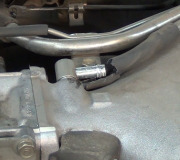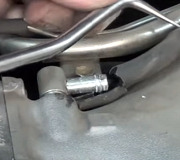If you're seeing this with four injectors disconnected, it is likely because the Engine Computer is anticipating its need to be in control of idle speed, and it picks a target "step" based on eight firing cylinders. If there are only four that are firing, idle speed will have to drop too low before the computer sees that and responds.
If this still occurs with all eight injectors working, it would be best to watch the idle steps on a scanner to see what is happening. If you see it at step "0", minimum throttle hasn't been relearned yet. If you see it considerably higher than step 32 while you're nearing the end of the slow-down, but the idle speed drops too low, it could be hanging up in second gear too long, or the idle air passage is plugged with carbon. If the step number goes up a lot while the low rpm picks back up relatively slowly, suspect an idle speed motor that is gummed up and sticking. The position of its armature is not monitored. The computer only knows when it needs to open the valve more, less, or hold it steady. The only way the computer knows the motor / valve's position is it runs it to "0" when the ignition switch is turned off, then it keeps pulsing it even more in case it needs more pulses to get it fully-closed. From there it pulses it back open about 50 steps and leaves it there. That is so it's ready to provide the idle flare-up to 1500 rpm for the next start.
In the late '80s to early '90s we had a lot of trouble with the air passage around the throttle blade getting plugged with carbon. Even though no gas flowed through that passage, fumes when the engine was stopped worked their way through the intake system and collected there. Eventually no air could get through so when the computer tried to raise idle speed, it held the injectors open longer to get more fuel, but the extra air to go with it couldn't get past that carbon blockage. We don't see that problem any more thanks to the improved fuel additives, but if that occurs where you are, if the passage is partially-plugged, the valve might have to open further than normal for the right amount of air to get in, and it takes a few seconds for that to occur. Now that I shared all that, it occurs to me that your engine uses the electronic throttle body assembly. Idle air is controlled by a motor opening the throttle blade. The rest of the operation is the same.
Related to this, fuel trim data will be relearned as you drive. If you're driving with half the injectors unplugged, the computer is going to see that as it needs twice as much fuel as expected, but it thinks it's going to get that fuel from eight injectors. Since only four are working, the computer won't see the need for still more fuel until idle speed has dropped too low.
I've thought about disabling injectors before, but first let me explain what else can happen. The Engine Computer is capable of detecting around 2,000 defects and setting diagnostic fault codes for them. About half of them pertain to things that could adversely affect emissions. Those are the codes that turn on the Check Engine light. Too little fuel from a variety of causes, including unplugged injectors, will cause incomplete combustion. That causes increased emissions, and therefore the Check Engine light will be on. Two things can happen when that light is on. The first is if a new, different problem is detected, you'll never know because the light is already on. You could be unaware of a new, relatively minor problem that can turn very expensive if it's ignored.
The second concern is when a problem is detected, a long list of conditions must be met for the fault code to set. One of those conditions always is that certain other codes can't already be set. For example, if there is a problem with, ... Oh, ... Lets say the coolant temperature sensor, and a fault code is set for it, any other circuit that uses that sensor's readings for comparison can't trust it, so tests for that second circuit will be suspended. The second problem will go undetected, and there won't be a fault code related to it, even though engine performance is affected. This is where it gets real frustrating for mechanics and owners. The mechanic only has the first fault code to go on when calculating a repair estimate. It isn't until that first problem is solved that the rest of the self-tests resume. THAT is when the second problem is detected, the new fault code is set, and the Check Engine light turns right back on. The customer incorrectly assumes the mechanic didn't diagnose the problem correctly or didn't fix it correctly. The mechanic is frustrated because he has to start the diagnostics all over again.
These undetected second or third problems become more of an issue when the first one is ignored for a long time. That gives the new problems more time to develop. This is real common on GM vehicles with multiple anti-lock brake system problems. Only the first one gets detected, then the system shuts down. By the time the owner finally takes it in for repair, a second problem has developed, but no one is aware of it until after the first one is fixed, and a test-drive is performed.
What we need to do is figure out how to trick the computer into not knowing the injectors are unplugged, and I have some ideas, but the next problem is the Engine Computer is constantly commanding the fuel / air mixture to switch between "rich" and "lean" about two times per second. When it goes rich, the extra, unburned fuel is stored in the catalyst in the catalytic converter. When it goes lean, the extra unburned air gets mixed with the fuel in the converter and is burned. You're going to have a sky-high lean exhaust from all the air leaving those four cylinders with no fuel to go with it. Based on the readings from the front oxygen sensors, the computer will only know the mixture is too lean, but it won't know why. It is going to try to correct that by increasing the amount of time the injectors are held open to get more fuel into the engine. It doesn't know that extra fuel is going into just four cylinders. It only knows no matter how much extra fuel it commands, the readings are still "lean". That will set the fault code, "running lean too long" and it will turn on the Check Engine light. You may think the engine is running on half the fuel as normal, but in reality, the working cylinders are getting a lot more fuel than normal, but with no additional air to go with it. That fuel will go into the exhaust, wasted, with increased emissions.
Rather than getting too long-winded at this point, find out what happens when you run with just one or two injectors unplugged. My 2014 Ran will cut off four injectors when that power isn't needed, but the computer is programmed to work with the misfires and to disregard them.
Have you looked into a "chip", meaning an add-on box that lets you ask for increased power and fuel mileage? From what I've been told, these are more effective with diesel engines but they do work with gas engines too. A former coworker had one on his Ram 1500 and claimed to get as high as 28 mpg back in the mid 2000s. The only thing to be aware of is the miles per gallon displayed on the dash is higher than the actual mileage you're getting, even though that mileage is improved.
Friday, February 9th, 2018 AT 7:09 PM


